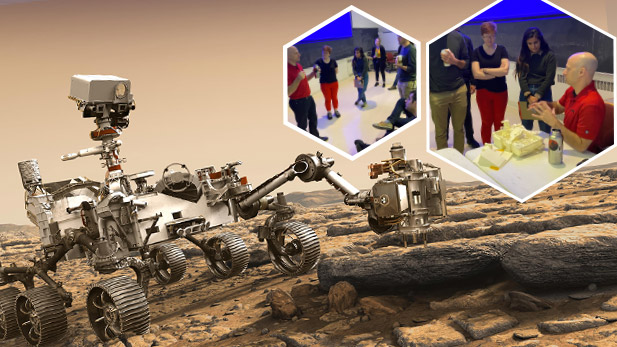NASA Optical Engineer Alumnus Hopes Mars Mission Unlocks Mystery of Red Planet Life

Applied optics alumnus Brian Monacelli is part of the NASA team that developed SHERLOC, a project to search for signs of ancient Martian life during the upcoming Mars 2020 mission.
To solve a mystery, Sherlock Holmes sometimes crawled on all fours at a crime scene scanning the ground for fresh clues.
Soon, NASA's own SHERLOC will be doing the same thing on Mars, thanks to the work of 2000 applied optics alumnus Brian Monacelli and a team of engineers and scientists at the space agency’s Jet Propulsion Laboratory (JPL) in California. Only instead of solving some Earth-bound mystery, NASA's SHERLOC will be trying to answer the question: Was there past life on Mars?
SHERLOC will be part of the Mars 2020 mission, launching from Florida in June. If all goes well, it will land in Jezero Crater on Mars in February 2021.
SHERLOC stands for Scanning Habitable Environments with Raman and Luminescence for Organics and Chemicals–a true mouthful. Attached to the Mars Rover, SHERLOC will use sophisticated optical devices, including an ultraviolet laser that fluoresces chemicals, to scan the surface and subsurface of Mars looking for organic and chemical evidence that life once existed on the Red Planet.
“It will be looking for chemicals that are indicative of life,” says Monacelli, a five-year veteran of NASA’s Mars 2020 mission team. He was responsible for the alignment and testing of SHERLOC’s optical systems.
NASA engineers will guide SHERLOC remotely from millions of miles away. It will not actually touch the surface of Mars but will closely observe it through a magnifying lens (the Sherlock Holmes comparison is just too easy here) about two inches from the red, dusty ground. And, like the fictional Holmes, the device will be assisted by Watson, the name NASA gave the rover’s main turret-mounted camera. Watson will provide a wide-angle view to complement the much more tightly focused view from SHERLOC’s camera.
One big challenge for NASA scientists was to make sure SHERLOC doesn't accidentally carry microbial life from Earth to the Martian surface. Any contaminants carried from Earth would corrupt the mission by adding a "background signal." That’s why the construction of SHERLOC and the rest of the mission’s equipment has been conducted in a cleanroom setting.
“SHERLOC is one of the cleanest instruments JPL has built. We want to measure for signs of Martian life, not for signs that we had pizza for lunch when we aligned its optics,” he says.
The Mars 2020 Perseverance rover mission is part of NASA's Mars Exploration Program, a long-term effort of robotic exploration of the planet. The Mars 2020 mission addresses high-priority science goals for Mars exploration, including key astrobiology questions about the potential for life on Mars.
According to NASA, the mission takes the next step by not only seeking signs of habitable conditions on Mars in the ancient past but also searching for signs of past microbial life itself. The Perseverance rover introduces a drill that can collect core samples of the most promising rocks and soils and set them aside in a "cache" on the surface of Mars. A future mission could potentially return these samples to Earth for study by scientists.
The mission also provides opportunities to gather knowledge and demonstrate technologies that address the challenges of future human expeditions to Mars. These include testing a method for producing oxygen from the Martian atmosphere, identifying other resources (such as subsurface water), and characterizing weather, dust, and other potential environmental conditions that could affect future astronauts living and working on Mars.